Pet Center Bundle
Can Petz, Brazil's Pet Retail Giant, Continue its Reign?
Petz, a leading Brazilian pet retailer, has carved a significant niche in the booming pet care industry, the third-largest globally. From its inception as a pioneering 24/7 pet shop, Petz has evolved into a market leader with a robust network of physical stores and a thriving e-commerce platform. This analysis dives deep into Petz's Pet Center SWOT Analysis, growth strategy, and future prospects in the dynamic pet market.
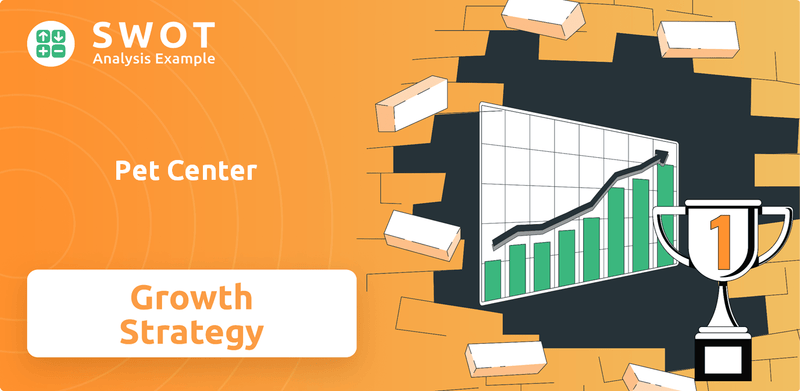
With the pet industry's continued expansion, understanding Petz's strategic initiatives is crucial for investors and industry professionals. This report provides a comprehensive pet market analysis, exploring the company's omnichannel approach, its success in online sales, and its plans for future expansion. We will examine the key factors driving Petz's growth and the opportunities within the animal care business, including the future of online pet supply businesses and the evolving landscape of pet services expansion, to help you make informed decisions.
How Is Pet Center Expanding Its Reach?
The company is actively pursuing several expansion initiatives to strengthen its market position in Brazil. A key strategic move involves a proposed merger with Cobasi, which, if approved by Brazil's Administrative Council for Economic Defense (CADE), would establish the largest pet retail company in the country. This consolidation aims to capitalize on opportunities within Brazil's fragmented pet care market.
Beyond potential mergers, the company is committed to organic growth through new store openings and product diversification. These efforts are part of a broader strategy to revitalize categories like 'accessories' and 'hygiene and cleaning,' which showed strong year-over-year growth in Q4 2024. The company is also strategically diversifying its revenue streams through new services and loyalty programs.
These initiatives are designed to attract new customers, enhance customer loyalty, and diversify revenue streams, allowing the company to stay ahead of industry changes and capitalize on the growing Brazilian pet care market. For more insights, consider reading the analysis on Owners & Shareholders of Pet Center.
The proposed merger with Cobasi aims to create the largest pet retail company in Brazil. The combined entity is projected to operate 494 stores across 140 Brazilian cities. This strategic move is designed to leverage market consolidation opportunities within Brazil's highly fragmented pet care market.
The merger is expected to generate an estimated R$6.9 billion (approximately $1.3 billion USD) in net revenue. This projection underscores the significant financial impact of the merger on the company's future performance and its potential to drive long-term value creation in the pet industry.
In Q1 2025, the company opened one new store, contributing to 14 new locations opened over the past year. The company plans to expand further in 2025, particularly in the pet toy category, with 'hundreds' of new SKUs expected. This expansion reflects a commitment to organic growth and product innovation.
The company is focusing on revitalizing categories like 'accessories' and 'hygiene and cleaning,' which showed strong year-over-year growth in Q4 2024 (15.6% and 16.4% respectively). The company also launched its 'Selections' dry food range in late 2024, featuring 20 SKUs for dogs and cats.
The company launched 'Seres Saúde,' a pet health insurance plan, in five São Paulo stores and expanded its 'Clubz' loyalty program nationally. The Clubz platform offers discounts, cashback, and personalized content across four membership tiers. The platform reported adding 554,000 subscribers in Q1 2025, a 19% year-over-year increase, accounting for 29% of total revenue.
- The Clubz program is being rolled out to physical stores in May 2025, transitioning from a digital-only format.
- These initiatives aim to attract new customers and enhance customer loyalty.
- The company is strategically diversifying its revenue streams through these new services.
- This expansion is designed to stay ahead of industry changes and capitalize on the growing Brazilian pet care market, supporting the pet center growth strategy.
Pet Center SWOT Analysis
- Complete SWOT Breakdown
- Fully Customizable
- Editable in Excel & Word
- Professional Formatting
- Investor-Ready Format
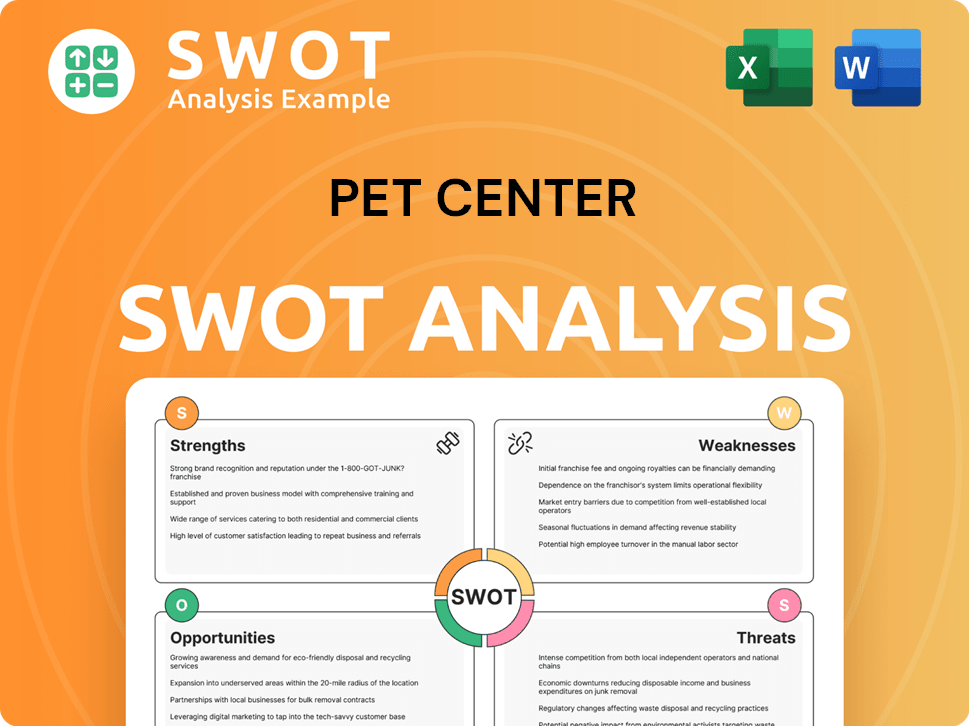
How Does Pet Center Invest in Innovation?
Innovation and technology are central to the growth strategy of the pet center company, driving its digital transformation and enhancing customer experiences. The company's focus on an omnichannel approach, integrating physical and digital channels, is a key aspect of its strategy. This approach allows for services like e-commerce, express delivery, and in-store pickup, aiming to meet the evolving needs of pet owners.
The company has invested heavily in digital platforms to improve customer engagement and loyalty. They have successfully integrated digital technologies with physical store experiences. This includes the use of apps and online platforms to provide a seamless shopping experience. This shows a commitment to adapting to the changing preferences of pet owners.
The company's commitment to innovation is evident in its product launches and platform enhancements. The company has focused on revitalizing product categories like accessories, hygiene, and cleaning, and launched new private label products, including a toy line that doubled its share and pet beds whose share tripled. The 'Selections' dry food line, launched in late 2024, also demonstrates Petz's investment in new product development.
Digital sales accounted for over 40% of the company's gross revenue in Q4 2023. This highlights the significant impact of e-commerce on the company's overall performance. This demonstrates the importance of online presence in the pet industry.
The company achieved an impressive omnichannel index of 92.1%. This high index indicates the effectiveness of integrating physical stores with digital platforms. This shows how well the company connects its online and offline services.
The company's app has over one million monthly active users. This high level of engagement suggests a strong customer base. This also indicates the success of their digital initiatives.
The expansion of the Clubz loyalty program is a key strategy for driving customer engagement. This program offers exclusive discounts and personalized content. This helps to retain customers and foster loyalty.
The company has focused on revitalizing product categories like accessories, hygiene, and cleaning, and launched new private label products. The 'Selections' dry food line, launched in late 2024, also demonstrates the investment in new product development. This demonstrates a commitment to meeting diverse customer needs.
The broader pet industry is seeing significant growth in technology-driven pet products, including smart feeders, health monitoring devices, and GPS-enabled collars. These trends suggest potential areas for future innovation. This indicates the direction of the Brief History of Pet Center.
The company's innovation strategy is centered around digital transformation and enhancing the customer experience. This includes a strong emphasis on e-commerce, express delivery, and in-store pickup. The company is also focusing on new product development and loyalty programs to drive customer engagement and loyalty.
- Digital Transformation: Over 40% of gross revenue from digital sales in Q4 2023.
- Omnichannel Strategy: An omnichannel index of 92.1%, integrating physical and digital channels.
- Customer Engagement: Over one million monthly active users on the company app.
- Product Innovation: Launch of new private label products and the 'Selections' dry food line.
- Loyalty Programs: Expansion of the Clubz loyalty program.
Pet Center PESTLE Analysis
- Covers All 6 PESTLE Categories
- No Research Needed – Save Hours of Work
- Built by Experts, Trusted by Consultants
- Instant Download, Ready to Use
- 100% Editable, Fully Customizable
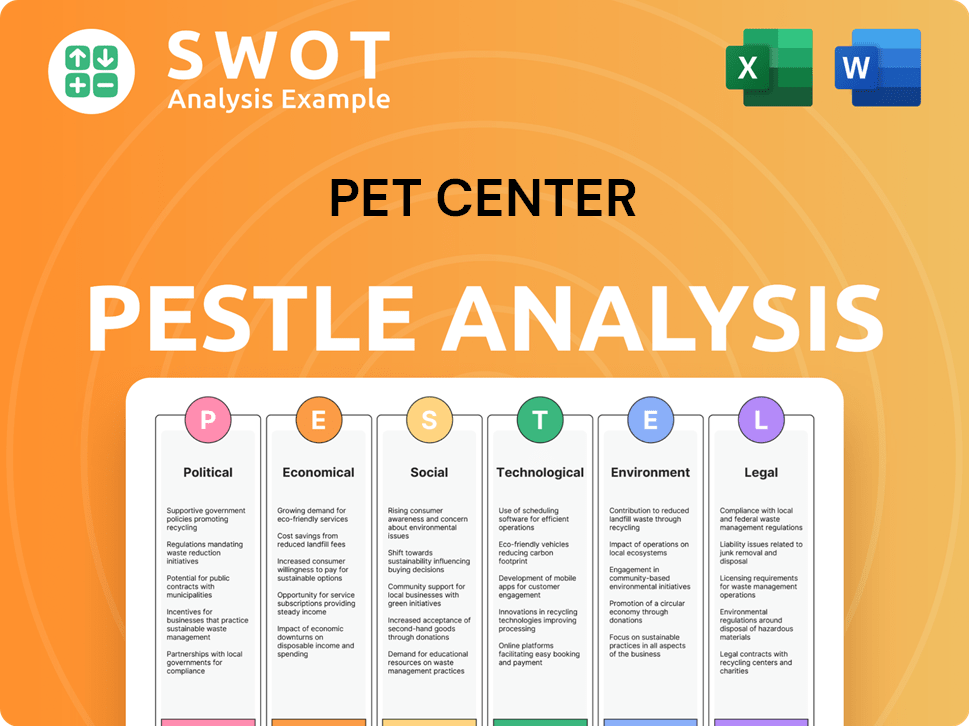
What Is Pet Center’s Growth Forecast?
The financial outlook for the company in early 2025 presents a mixed scenario. While the company experienced strong revenue growth, profitability faced significant challenges. This performance reflects the dynamic nature of the pet industry and the impact of strategic decisions on financial outcomes. Understanding these factors is crucial for assessing the company's future prospects and growth strategy.
In Q1 2025, the company saw a 7.9% year-over-year increase in net revenue, reaching R$839.2 million (approximately $139.9 million USD). This growth was driven by solid performance in both physical stores and e-commerce. However, the company also faced operational bottlenecks and cost pressures, impacting its profitability. The company's ability to navigate these challenges will be critical for its long-term success.
The company's private label products are performing well, with sales surging 31% in Q1 2025 and now comprising 18% of total sales. Despite this revenue growth, adjusted net profit in Q1 2025 collapsed by 86.7% to R$1.06 million (approximately $0.18 million USD). This decline was primarily attributed to operational bottlenecks and cost pressures stemming from a warehouse expansion project that led to overcrowding and reduced productivity, along with increased selling, general, and administrative expenses (up 10.6% to R$379 million).
The company experienced a 7.9% year-over-year increase in net revenue in Q1 2025, reaching R$839.2 million (approximately $139.9 million USD). Physical store sales grew by 10% and e-commerce revenue climbed by 8%, with same-store sales increasing by 6%. This growth demonstrates the company's ability to capture market share.
Adjusted net profit in Q1 2025 decreased by 86.7% to R$1.06 million (approximately $0.18 million USD). This decline was primarily due to operational bottlenecks and increased expenses. Adjusted EBITDA fell by 6.9% to R$55.99 million (approximately $9.3 million USD), with EBITDA margins squeezing to 6.7% from 7.6% a year earlier.
Net debt increased to R$75.8 million (approximately $12.6 million USD) from R$10.7 million (approximately $1.8 million USD) in Q1 2024. Capital expenditures decreased by 14.4% to R$30.3 million (approximately $5.1 million USD). Free cash flow turned negative at -R$11 million (approximately -$1.8 million USD).
The proposed merger with Cobasi is expected to generate R$6.9 billion in annual revenue and R$464 million in EBITDA. The pet market is projected to reach $17.10 billion by 2029, growing at a CAGR of 12.78% from 2024 to 2029. This growth presents significant opportunities for the company.
The company's strategic initiatives, including the proposed merger with Cobasi, are crucial for its long-term growth. This merger is anticipated to create Brazil's largest pet retail company and capture a larger share of the expanding pet market. The Target Market of Pet Center is also a key factor in the company's growth strategy. The pet industry's future looks promising, with the market expected to reach $17.10 billion by 2029, growing at a CAGR of 12.78% from 2024 to 2029. This growth provides significant opportunities for the company's expansion and success.
Pet Center Business Model Canvas
- Complete 9-Block Business Model Canvas
- Effortlessly Communicate Your Business Strategy
- Investor-Ready BMC Format
- 100% Editable and Customizable
- Clear and Structured Layout
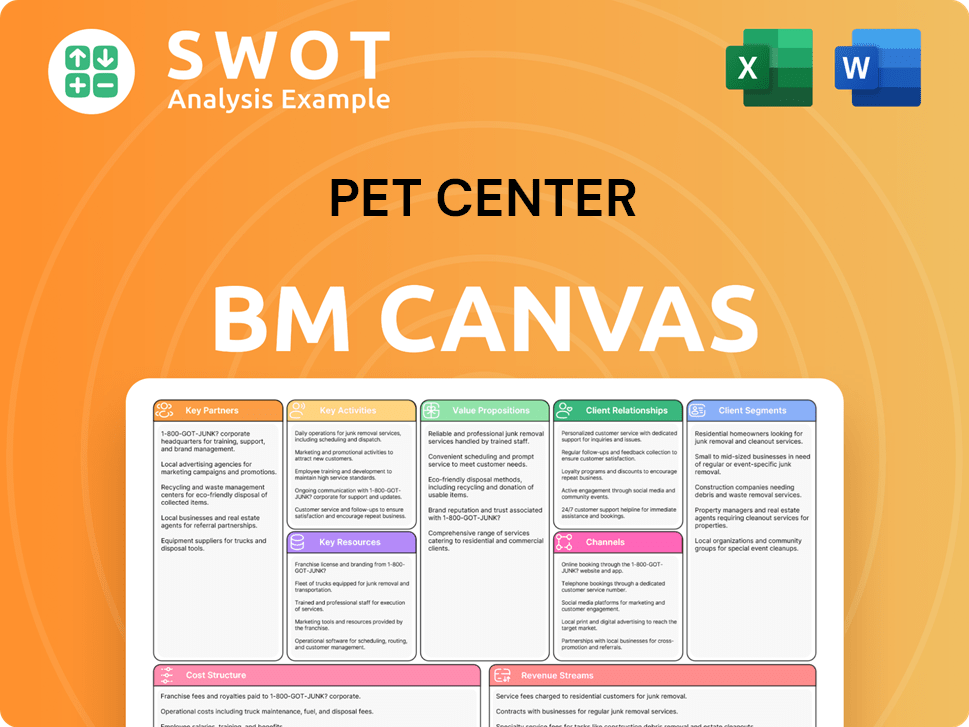
What Risks Could Slow Pet Center’s Growth?
The pet center faces several potential risks and obstacles that could hinder its growth trajectory. These challenges span market competition, operational inefficiencies, and external industry factors. Understanding and proactively managing these risks is crucial for the company's sustained success in the dynamic pet care market.
Market competition in Brazil's pet care industry poses a significant hurdle. Furthermore, the proposed merger with Cobasi is under review by Brazil's Administrative Council for Economic Defense (CADE), which could require remedies to address market concentration concerns. Operational challenges, such as distribution center issues, also threaten profitability and efficiency.
External factors, including regulatory changes, supply chain vulnerabilities, and technological disruption, add further complexity. While the company employs strategies to mitigate some of these risks, continuous monitoring and proactive risk management are essential for navigating the evolving pet industry landscape. Consider the Competitors Landscape of Pet Center to better understand the competitive environment.
The pet center operates in a highly competitive market with numerous players, including large chains, smaller stores, online marketplaces, and supermarkets. This intense competition can put pressure on pricing and market share. The company must differentiate itself through superior customer service, product offerings, and marketing strategies to maintain a competitive edge.
The proposed merger with Cobasi faces scrutiny from CADE, which could impose conditions or even block the deal. The review is expected to conclude by July 9, 2025. Any required remedies, such as store divestitures, could impact the company's expansion plans and financial performance.
The company experienced significant operational challenges, such as distribution center issues, during Q1 2025. Warehouse expansion projects led to overcrowding, reduced productivity, and a surge in inventory levels. These issues resulted in increased expenses and could negatively affect profitability and operational efficiency.
Supply chain disruptions due to natural disasters, trade disputes, or pandemics can lead to shortages of pet products and increased costs. The pet industry depends on a stable supply chain to ensure product availability and maintain profitability. The company must have robust supply chain management practices to mitigate these risks.
The rise of online shopping platforms and pet care apps poses a threat to traditional pet stores. The company must adapt to the changing consumer behavior and invest in e-commerce capabilities, digital marketing, and online pet services to stay competitive. Failure to do so could result in lost market share.
Changes in product registration legislation and potential tax reforms can impact the pet industry. The company must closely monitor and adapt to any regulatory changes that could affect its operations. Compliance costs and potential tax implications could impact profitability.
The company employs a diversified omnichannel strategy, combining physical stores and online platforms, to mitigate risks. The focus on private label products helps improve gross margins and reduce dependence on external suppliers. Continuous monitoring of external factors and proactive risk management frameworks are crucial for sustained growth.
In Q1 2025, the company experienced a R$12 million increase in inventory levels due to distribution center issues. Increased selling, general, and administrative expenses were a result of temporary labor hires. The company's ability to manage these costs and improve operational efficiency will be critical for financial performance.
Pet Center Porter's Five Forces Analysis
- Covers All 5 Competitive Forces in Detail
- Structured for Consultants, Students, and Founders
- 100% Editable in Microsoft Word & Excel
- Instant Digital Download – Use Immediately
- Compatible with Mac & PC – Fully Unlocked
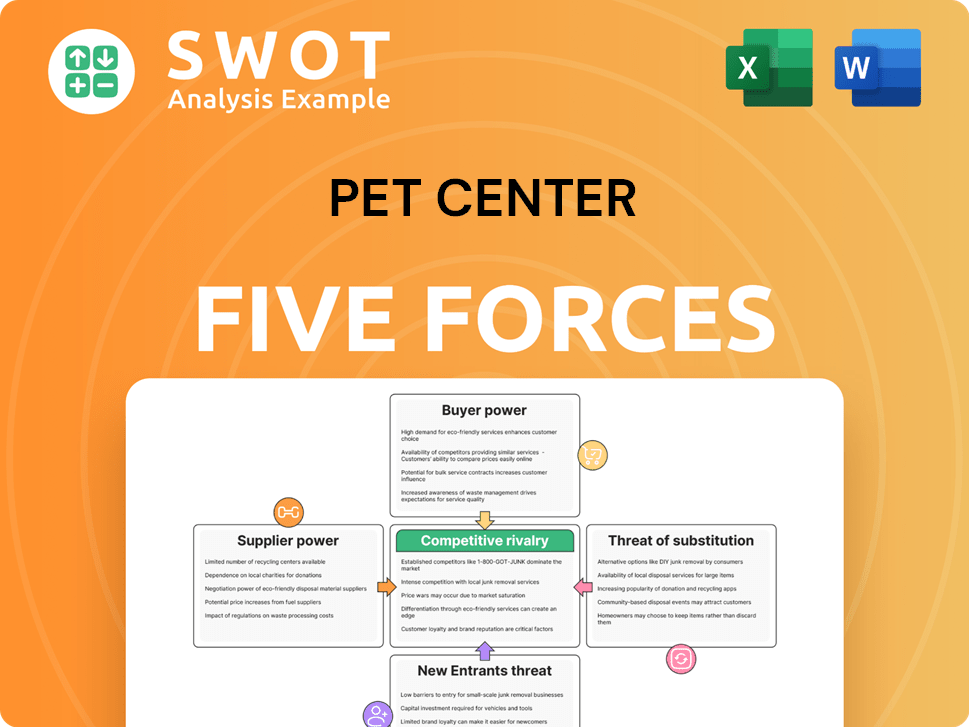
Related Blogs
- What are Mission Vision & Core Values of Pet Center Company?
- What is Competitive Landscape of Pet Center Company?
- How Does Pet Center Company Work?
- What is Sales and Marketing Strategy of Pet Center Company?
- What is Brief History of Pet Center Company?
- Who Owns Pet Center Company?
- What is Customer Demographics and Target Market of Pet Center Company?
Disclaimer
All information, articles, and product details provided on this website are for general informational and educational purposes only. We do not claim any ownership over, nor do we intend to infringe upon, any trademarks, copyrights, logos, brand names, or other intellectual property mentioned or depicted on this site. Such intellectual property remains the property of its respective owners, and any references here are made solely for identification or informational purposes, without implying any affiliation, endorsement, or partnership.
We make no representations or warranties, express or implied, regarding the accuracy, completeness, or suitability of any content or products presented. Nothing on this website should be construed as legal, tax, investment, financial, medical, or other professional advice. In addition, no part of this site—including articles or product references—constitutes a solicitation, recommendation, endorsement, advertisement, or offer to buy or sell any securities, franchises, or other financial instruments, particularly in jurisdictions where such activity would be unlawful.
All content is of a general nature and may not address the specific circumstances of any individual or entity. It is not a substitute for professional advice or services. Any actions you take based on the information provided here are strictly at your own risk. You accept full responsibility for any decisions or outcomes arising from your use of this website and agree to release us from any liability in connection with your use of, or reliance upon, the content or products found herein.